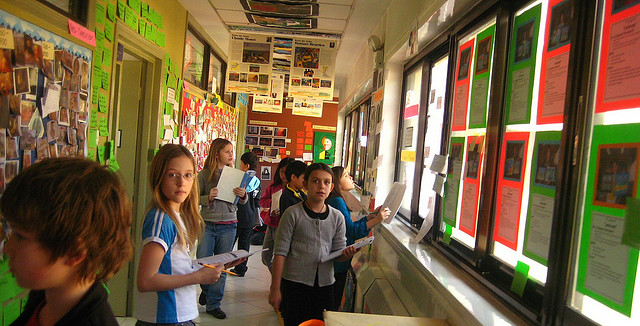This article lists the different types of learners.
Contents
- Visual-Auditory-Kinesthetic Theory
- Hemispheric Dominance Theory
- Experiential Learning Style Theory
- Planning for Learning Styles
- Useful Websites and Resources
- Videos
Each student is a unique package, but they can be grouped according to their learning styles.
There are three major theories about learning style to consider.
Each theory has value and offers helpful ideas, so teachers should consider all possibilities and combinations when planning lessons.
Visual-Auditory-Kinesthetic Theory
This familiar theory tells us that students learn best by seeing, hearing, moving or a combination of the three.
When teaching visual learners, teachers need to provide posters, digital displays, books or handouts with graphics.
Use color, size and position to highlight information.
For auditory learners, present information through discussion, lecture, reading aloud or recorded interviews.
Kinesthetic learners will appreciate experiments, demonstrations and videos.
Hemispheric Dominance Theory
The notion of being “right-brained” or “left-brained” comes from the Hemispheric Dominance Theory.
This theory holds that language, logic and seeing the whole are the province of the left side of the brain and creative thought, insight and intuition come from the right side.
One side or the other is usually dominant, and this impacts how students learn best.
Teach right-brained students by giving them lots of facts and information.
Their dominant way of thinking will help them connect pieces into a whole idea.
Teach left-brained students by presenting the whole and allowing them to analyze and pick apart the pieces.
Show them connections and ideas and they will be able to understand the big picture more fully.
Experiential Learning Style Theory
The Experiential Learning Style Theory explains learning preferences in terms of two sliding scales.
The perceptual scale tells how students like to take in information.
Learners may prefer to get their knowledge by directly observing things or by spending quiet time reflecting and thinking about their world.
The processing scale tells how they like to work with information.
Some have a pronounced preference for direct, active experiences and others prefer reflecting and observing.
Both aspects are based on sliding scales, where learners are judged to be more like one end or the other, but few are completely described at either extreme.
Put the scales together in a cross form, and you can categorize learners into four groups based on which ends of the two scales are more applicable.
Divergent learners like to feel and watch.
Try brainstorming, cooperative learning, and imaginative techniques.
Assimilating Learners like to think and watch.
They move from details to larger concepts, so models, experiments and projects are effective.
Converging learners like to think and do.
Use problem solving, application and independent work to teach this group effectively.
Accommodating Learners like to feel and do.
Discovery learning and trial and error techniques can be most effective.
Planning for Learning Styles
Of course, groups of students will contain all of these types of learners.
Furthermore, most people are not clearly at any extreme but rather have tendencies and preferences to one type or another.
Stress, interest, experience and group dynamics can also impact students’ learning styles.
So how does one manage to meet all of these divergent needs within the same classroom and lesson?
The answer is to use a multitude of presentation techniques to help students understand the information and to offer a range of response pathways to cement learning and demonstrate mastery.
Present information with hands-on techniques such as demonstrations or models, use visual prompts and cues like posters, banners, and graphics, lecture while using Smartboard or Powerpoint presentations, and so forth.
Provide practice opportunities and assessment by allowing students to choose from an array of assignments including projects, reports or presentations, problems to solve, webquests, interviews and so forth.
Evaluate student progress by setting goals and objectives for each teaching unit then grading with a rubric-based system.
Useful Websites and Resources
These websites provide additional information about learning styles and how to use the information to design effective lessons.
There are also quizzes and tools to help teachers and students discover more about their personal learning styles.
- http://www.nwlink.com/~donclark/hrd/styles/kolb.html
- http://www.leapingfromthebox.com/art/kmg/learningstyles2.html
- http://frank.mtsu.edu/~studskl/hd/learn.html
- http://www.nwlink.com/~donclark/hrd/styles/honey_mumford.html
- http://njaes.rutgers.edu/learnbydoing/weblinks.html
Videos
The following videos may be useful for anyone that wants to learn more about the different types of learners.

